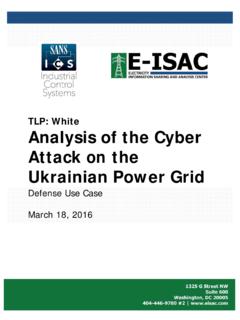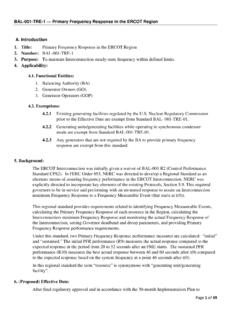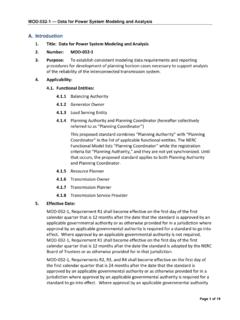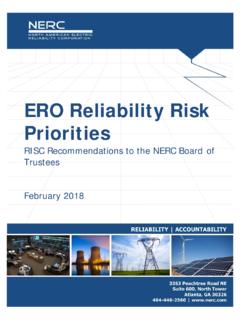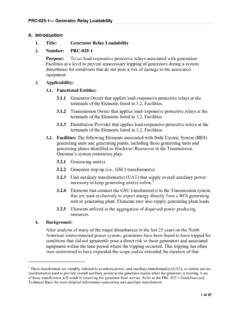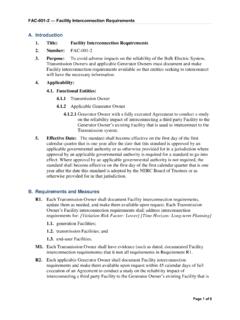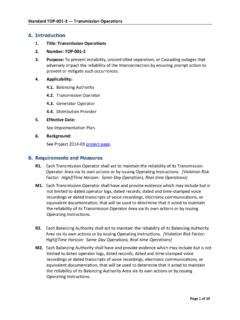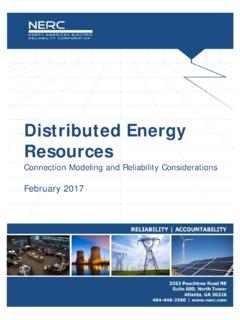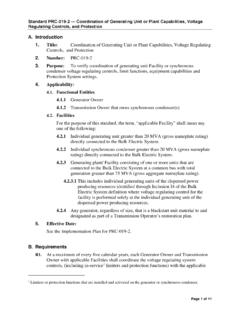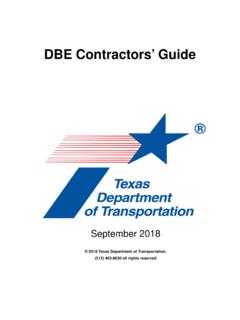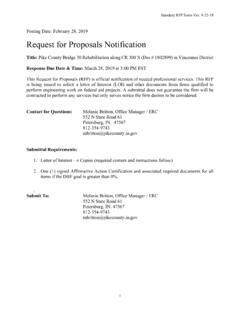Transcription of Bulk Electric System Definition Reference Document
1 NERC | Bulk Electric System Definition Reference Document | April 2014 1 of 85 Bulk Electric System Definition Reference Document Version 2 | April 2014 3353 Peachtree Road NE Suite 600, North Tower Atlanta, GA 30326 404-446-2560 | This technical Reference was created by the Definition of Bulk Electric System drafting team to assist entities in applying the Definition . It should be read in concert with the complete Definition , found in the NERC Glossary of Terms, and any guidance issued by the ERO. The process for handling requests for exceptions to the Definition is found in Appendix 5c of the NERC Rules of Procedure. Both the NERC Glossary of Terms and Rules of Procedure are posted on the NERC website.
2 NERC | Bulk Electric System Definition Reference Document | April 2014 2 of 85 Table of Contents Table of Contents .. 3 Introduction .. 4 I. List of Figures .. 8 II. Inclusions .. 10 III. Exclusions .. 27 IV. Hierarchical Application of the Definition .. 68 V. Availability of Exception Process .. 84 VI. Version History .. 85 NERC | Bulk Electric System Definition Reference Document | April 2014 3 of 85 Introduction During the course of Project 2010 17 Definition of Bulk Electric System (DBES), several commenters requested that the Standard Drafting Team (SDT) create a Reference Document explaining how the revised Definition should be applied. This Document is intended to provide such a Reference . Disclaimer This Document is not an official position of NERC and will not be binding on enforcement decisions of the NERC Compliance Monitoring and Enforcement Program.
3 This Reference Document reflects the professional opinion of the DBES SDT, given in good faith for illustrative purposes only. Background On November 18, 2010 FERC issued Order No. 743 and directed NERC to revise the Definition of the Bulk Electric System (BES) so that the Definition encompasses all Elements and Facilities necessary for the reliable operation and planning of the interconnected Bulk Power System . The revisions to the Definition were developed in two phases. The final revised Definition was approved by the Federal Energy Regulatory Commission (FERC or the Commission) on March 20, 2014. Purpose The purpose of this Document is to assist the industry with the application of the revised Definition .
4 Examples are provided where appropriate but should not be considered as all inclusive. The Document is intended to provide clarification and explanations for the application of the revised Definition in a consistent, continent wide basis for the majority of BES Elements. Definition Bulk Electric System (BES): Unless modified by the lists shown below, all Transmission Elements operated at 100 kV or higher and Real Power and Reactive Power resources connected at 100 kV or higher. This does not include facilities used in the local distribution of Electric energy. Inclusions: I1 Transformers with the primary terminal and at least one secondary terminal operated at 100 kV or higher unless excluded by application of Exclusion E1 or E3.
5 I2 Generating resource(s) including the generator terminals through the high side of the step up transformer(s) connected at a voltage of 100 kV or above with: Gross individual nameplate rating greater than 20 MVA. Or, Gross plant/facility aggregate nameplate rating greater than 75 MVA. I3 Blackstart Resources identified in the Transmission Operator s restoration plan. I4 Dispersed power producing resources that aggregate to a total capacity greater than 75 MVA (gross nameplate rating), and that are connected through a System designed primarily for delivering such capacity to a common point of connection at a voltage of 100 kV or above. Thus, the facilities designated as BES are: The individual resources, and The System designed primarily for delivering capacity from the point where those resources aggregate to greater than 75 MVA to a common point of connection at a voltage of 100 kV or above.
6 Introduction NERC | Bulk Electric System Definition Reference Document | April 2014 4 of 85 I5 Static or dynamic devices (excluding generators) dedicated to supplying or absorbing Reactive Power that are connected at 100 kV or higher, or through a dedicated transformer with a high side voltage of 100 kV or higher, or through a transformer that is designated in Inclusion I1 unless excluded by application of Exclusion E4. Exclusions: E1 Radial systems: A group of contiguous transmission Elements that emanates from a single point of connection of 100 kV or higher and: Only serves Load. Or, Only includes generation resources, not identified in Inclusions I2, I3, or I4, with an aggregate capacity less than or equal to 75 MVA (gross nameplate rating).
7 Or, Where the radial System serves Load and includes generation resources, not identified in Inclusions I2, I3 or I4, with an aggregate capacity of non retail generation less than or equal to 75 MVA (gross nameplate rating). Note 1 A normally open switching device between radial systems, as depicted on prints or one line diagrams for example, does not affect this exclusion. Note 2 The presence of a contiguous loop, operated at a voltage level of 50 kV or less, between configurations being considered as radial systems, does not affect this exclusion. E2 A generating unit or multiple generating units on the customer s side of the retail meter that serve all or part of the retail Load with Electric energy if: (i) the net capacity provided to the BES does not exceed 75 MVA, and (ii) standby, back up, and maintenance power services are provided to the generating unit or multiple generating units or to the retail Load by a Balancing Authority, or provided pursuant to a binding obligation with a Generator Owner or Generator Operator, or under terms approved by the applicable regulatory authority.
8 E3 Local networks (LN): A group of contiguous transmission Elements operated at less than 300 kV that distribute power to Load rather than transfer bulk power across the interconnected System . LN s emanate from multiple points of connection at 100 kV or higher to improve the level of service to retail customers and not to accommodate bulk power transfer across the interconnected System . The LN is characterized by all of the following: Limits on connected generation: The LN and its underlying Elements do not include generation resources identified in Inclusions I2, I3, or I4 and do not have an aggregate capacity of non retail generation greater than 75 MVA (gross nameplate rating); Real Power flows only into the LN and the LN does not transfer energy originating outside the LN for delivery through the LN.
9 And Not part of a Flowgate or transfer path: The LN does not contain any part of a permanent Flowgate in the Eastern Interconnection, a major transfer path within the Western Interconnection, or a comparable monitored Facility in the ERCOT or Quebec Interconnections, and is not a monitored Facility included in an Interconnection Reliability Operating Limit (IROL). E4 Reactive Power devices installed for the sole benefit of a retail customer(s). Note Elements may be included or excluded on a case by case basis through the Rules of Procedure exception process. Introduction NERC | Bulk Electric System Definition Reference Document | April 2014 5 of 85 Summary An understanding of the core Definition and each Inclusion and Exclusion is necessary to accurately and consistently apply the BES Definition .
10 (It should be noted that the BES Definition applies to AC and DC electrical facilities.) The application of the bright line BES Definition is a three step process that, when appropriately applied, will identify the vast majority of BES Elements in a consistent manner that can be applied on a continent wide basis. FERC Order No. 773 directed implementation of the revised BES Definition to take into account the impact of sub 100 kV looped Facilities regardless of voltage level. This altered previous guidance on the evaluation of radial systems. The drafting team developed a technical justification setting a threshold of 50 kV as the value where looped facilities had potential impact on the BES, , if a looped Facility was below 50 kV, an entity could still apply Exclusion E1 as it was shown that looped facilities below 50 kV had no impact on the reliability of the BES.
